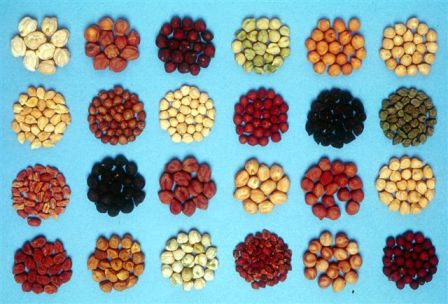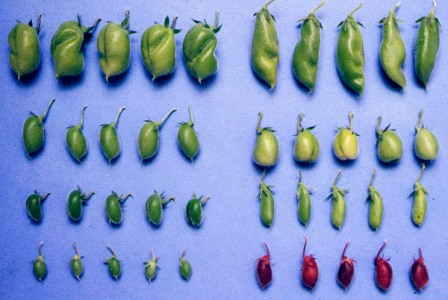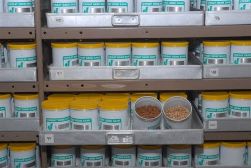Conservation of chickpea genetic resources
Contributors to this page: ICRISAT, Patancheru, India (Hari D Upadhyaya, Shivali Sharma, Cholenahalli L Laxmipathi Gowda, Dintyala Sastry, Sube Singh); NBPGR, New Delhi, India (Shyam Sharma); ICARDA, Aleppo, Syria (Ahmed Amri, Kenneth Street, Natalya Rukhkyan), SARC-RIPP, Piestany, Slovak Republic (Gabriela Antalikova); Institute of Plant Genetic Resources ‘K.Malkov’, Sadovo, Bulgaria (Siyka Stoyanova); Department of Primary Industries, Victoria, Australia (Bob Redden); IPK, Gatersleben, Germany (Andreas Börner).
Importance of chickpea conservation
Archeological chickpea remains found from Syria to Greece dating from the very early days of farming show its important role in the dispersal of farming habits. Like many other crops, it has been subjected to different selection pressures in various ecological and cultural environments and consequently diversified into a range of varieties. It is likely that chickpea has a higher potential to yield more than the yields currently achieved on farmers' fields. This potential can only be fully utilized if a broad range of genetic materials are available to select from or to breed for specific traits. Therefore, breeding for higher and more stable yields and also for enhanced resistance to pests and diseases is one of the immediate objectives of many chickpea programmes.
- A more efficient and effective conservation of the chickpea genepool worldwide, including both cultivated and wild species, is essential and potentially very important for research and crop improvement.
- Some of the wild relatives are potentially important to incorporate resistance to abiotic and biotic stresses.
- Tolerance to drought is a particularly important trait for chickpea that often grows in extremely harsh and dry environments.
- Priority should be given to conservation of chickpea in primary and secondary centres of diversity.
- Urgent priorities identified for chickpea conserved in many genebanks are the need for regeneration, characterization, safety duplication and long-term conservation.
- Cicer genetic resources could be much better utilized if a representative core collection (10% of the entire collection) and a mini core collection (10% of the core or 1% of entire collection) are developed and evaluated extensively for useful traits.
- More data is available at the accession level for economic traits to identify trait-specific germplasm.
- Many small collections contain unique materials that can be extremely important for the genetic improvement of the crop.
 Chickpea seed diversity (photo: ICRISAT) |
 Chickpea diversity of pods (photo: ICRISAT) |
 Chickpea germplasm diversity in the field (photo: ICRISAT) |

A chickpea genebank (photo: ICRISAT) |
Major chickpea collections
Chickpea collections include landraces, breeding material and wild species. It is estimated that more than 80 000 accessions are conserved in more than 30 genebanks worldwide. The genebank at ICRISAT Patancheru, India, is one of the largest genebanks holding >20 000 accessions of chickpea from 60 countries. Other major collections (more than 5000 accessions) are held at NBPGR, New Delhi, India; ICARDA Aleppo, Syria; Australian temperate field crops collection, Victoria, Australia; USDA, USA and the Seed and Plant Improvement Institute, Iran.
It was only after 1970 that wild Cicer species were actively collected. Currently there is a reasonable number of wild annual species but still limited availability of perennial species. Less than 1% of the Cicer accessions (conserved in about tengenebanks worldwide) represent wild species. The ICRISAT genebank holds 308 accessions belonging to 18 species of wild Cicer from 14 countries.
References and further reading
Abbo S, Redden RJ, Yadav SS. 2007. Utilization of wild relatives. In: Yadav SS, Redden R, Chen W, Sharma B, editors. Chickpea Breeding & Management. CABI, Wallingford, UK. pp 338-354.
Chickpea [online]. Available from URL: http://www.icrisat.org/crop-chickpea.htm. Date accessed: 29 January 2010.
FAO/IPGRI. 1994. Genebank standards. Food and Agriculture Organization of the United Nations, Rome and International Plant Genetic Resources Institute, Rome. Available in English, Spanish, French and Arabic.
Global Crop Diversity Trust. 2008. Global strategy for the ex situ conservation of chickpea (Cicer L.) [online]. Available from: http://www.croptrust.org/documents/web/CicerStrategy_FINAL_2Dec08.pdf. Date accessed: 25 May 2009.
IBPGR, ICRISAT, ICARDA. 1993. Descriptors for Chickpea (Cicer arietinum L.). International Board for Plant Genetic Resources, Rome, Italy; International Crops Research Institute for the Semi-Arid Tropics, Patancheru, India and International Center for Agricultural Research in the Dry Areas, Aleppo, Syria. ISBN 92-9043-137-7. Available here.
ICRISAT Chickpea Germplasm Collection Reports. Genetic Resources Unit, International Crops Research Institute for the Semi-Arid Tropics, Patancheru, A.P. 502 324, India. GRU - Progress Reports – 20 no’s.
ICRISAT Chickpea collection. SINGER [online]. Available from http://www.singer.cgiar.org/index.jsp?page=showkeycount&search=coc=co38. Date accessed: 30 January 2010.
Hanson J. 1985. Procedures for handling seeds in genebanks. Practical manuals for genebanks no. 1. International Board for Plant Genetic Resources. http://www.bioversityinternational.org/index.php?id=19&user_bioversitypublications_pi1[showUid]=2235.
Jambunathan R, Singh U, Subramanian V. 1981. Grain quality of sorghum, pearl millet, pigeonpea and chickpea. In: Proceedings of a workshop held at International Crops Research Institute for the Semi-Arid Tropics, Patancheru-502 324, Andhra Pradesh, India.
Singh KB, Pundir RPS, Robertson LD, van Rheene HA, Singh U, Kelley TJ, Rao PP, Johansen C, Saxena NP. 1997. Chickpea. In: Fuccillo D, Sears L, Stapleton P, editors. Biodiversity in Trust. Cambridge University Press. pp. 100-113.
Rao NK, Hanson J, Dulloo ME, Ghosh K, Nowel D, Larinde M. 2006. Manual of seed handling in genebanks. Handbooks for Genebanks No. 8. Bioversity International, Rome, Italy. Available in English (1.5 MB), Spanish (1.4 MB) and French (1.9 MB).
Redden B, Furman BJ, Upadhyaya HD, Pundir RPS, Gowda CLL, Coyne C, Enneking D. 2007. Biodiversity Management in Chickpea. In: Yadav SS, Redden R, Chen W, Sharma B, editors. Chickpea Breeding & Management. CABI, Wallingford, UK. pp 355-368.
Upadhyaya HD, Gowda CLL, Sastry DVSSR. 2008. Management of germplasm collections and enhancing their use by mini core and molecular approaches. APEC-ATCWG Workshop. Capacity building for risk management systems on genetic resources. pp. 35-70. http://www.tari.gov.tw/taric/uploads/publication_no135_08.pdf.
Upadhyaya HD, Gowda CLL, Sastry DVSSR. 2008. Plant genetic resources management: collection, characterization, conservation and utilization. Journal of SAT Agricultural Research 6. http://www.icrisat.org/Journal/Volume6/ChickPea_PigeonPea/HD_Upadhyaya.pdf.
Upadhyaya HD, Laxmipathi Gowda CL. 2009. Managing and Enhancing the Use of Germplasm – Strategies and Methodologies. Technical Manual no. 10. Patancheru 502 324, Andhra Pradesh, India: International Crops Research Institute for the Semi-Arid Tropics. 236 pp.
Comments
- No comments found





Leave your comments
Post comment as a guest